Archive for April, 2009
Killer Sudoku Multiplication
Apr 30th
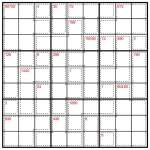
Killer Sudoku Multiplication 9×9 puzzle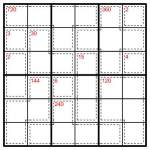
Killer Sudoku Multiplication 6×6 puzzle
I thought it would be interesting to see what a Killer Sudoku puzzle would look like if every operation in it was multiplication, so I decided to try it out.
The puzzles attached aren’t labelled with ‘x’ signs, but it should be fairly obvious from the totals that addition is not enough! Single-cell regions are simply equal to the stated value, but in all others you must multiply all of the cell values together to give the total at the top-left. Note that this follows Killer Sudoku rules, so a number cannot be repeated within a region.
These are all definitely rated ‘gentle’ – the logic required is simple, even though the multiplication might appear intimidating! In actual fact you don’t need to calculate most of the big values – try the 6×6 puzzle first to see why this is.
Good luck!
PS Subtraction and division are less interesting, unless you allow negative or fractional numbers! I’ll probably post examples of both the next couple of days anyway however!
Word ladder solutions
Apr 30th

Tricky Clones solution
Lovely Manors solution
Tough Places solution
Easy Life solution
Just a quick post to give the solutions I have for the word ladders I posted last week. There are sure to be alternative solutions, including one I found already with one less step for TRICKY CLONES as mentioned previously (not shown in the solution here, which uses the given number of steps).
Samurai Star Killer Sudoku
Apr 29th
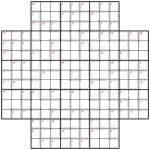
Samurai Star Killer (gentle) puzzle
“Star Killer” sounds like something out of science fiction, but it’s now definitely reality with this 5-grid Killer Sudoku puzzle. The actual Killer part uses the most basic logic imaginable, and there are a lot of ’singleton’ regions which I’ve never used in a Killer puzzle before. The reason for this is that I wanted to start at a gentle level – as a result this mostly solves like a regular Samurai Star (a.k.a. Flower Samurai) puzzle, with the Killer regions used occasionally to either get you going or help you out with a quick number along the way. It shouldn’t take you much over 20 or 30 minutes if you’ve solved this shape of Samurai before, and know what a Killer Sudoku is!
The rules are pretty simple: place 1 to 9 into each row, column and bold-lined 3×3 shape of each of the 5 underlying 9×9 grids (there’s one in the centre too), whilst also placing numbers so that the total in each dashed-line cage is equal to that given in the top-left corner. You may not repeat a number within a dashed-line cage.
The puzzle has rotation symmetry order 4, so the cages are in a pleasing pattern I hope – I particularly like the hole in the square in the centre! I think by and large that if you can create the cages or givens in a puzzle with the same order of symmetry that you have for the grid layout itself that this generally leads to a more pleasing appearance for the puzzle; but more than this, I find that this tends to follow through with the solving process, and you end up with pieces of the puzzle that feel ’sympathetic’ to one another, since the symmetry leads to related discoveries. However it’s perhaps not clear that this solving benefit carries through to a puzzle this large, and it’s probably the case that a puzzle with entirely random cages would feel just the same to actually solve at this size. But it wouldn’t look as nice!
Coming up in the following days I’m going to experiment in the space between Killer Sudoku and Ken Ken™ – in other words, using more operations than just addition, and possibly allowing repeated numbers in cages (although not on puzzles with 1-9 to place!). I already came across a puzzle called ‘Killer Sudoku Pro’ in the Saturday Telegraph newspaper (UK) – in this they keep the Killer Sudoku rules about not repeating digits in a cage, but specify different operations for cages (in actual fact the rules aren’t stated next to the puzzle in full, but I presume repeated digits are disallowed - it certainly solves okay with that assumption!). I haven’t seen anything precisely like that elsewhere and I thought it was actually quite fun (it wasn’t too hard!) so I’ll definitely try making some of those soon for sure. If you have any other ideas for how to mix these different types together feel free to post a comment!
Good luck!
Skyscraper Puzzles
Apr 28th
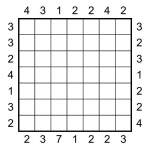
Skyscraper 7×7 puzzle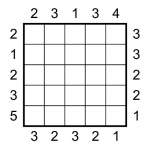
Skyscraper 5×5 puzzle
It occurs to me that I haven’t yet posted a regular, vanilla Skyscraper puzzle, so I decided that today was the day to rectify that! The 5×5 puzzle attached is pretty easy – it can be solved in under a minute if you’re on your toes! The 7×7 is nowhere near as hard as many of the puzzles I’ve posted recently, but it will certainly take longer than that.
The rules are simple: place 1 to 5 (or 1 to 7) into each row and column whilst obeying the skyscraper constraints. In Skyscraper puzzles each number in the completed grid represents a building of that many storeys, so the aim is to place the buildings in such a way that each given number outside the grid represents the number of buildings that can be seen from that point, looking along the adjacent row/column. A building with a higher value always obscures a building with a lower value, and a building with a lower value never obscures a building with a higher value. (Click back and look at some of my older posts for more details and examples)
Also, I want to say thanks very much for all of the fantastic comments that have been posted in response to my other puzzles – I’ve read them all and taken note and am working on suitable puzzles to follow up! ![]()
Consecutive 5-grid Samurai Sudoku
Apr 24th
I thought it would be a nice idea to create a large Consecutive Sudoku for the weekend! And so here one is: a 5-grid Samurai Consecutive Sudoku. As you can see, there are very few givens to start with, so it will hopefully be at least a bit of a challenge! (It shouldn’t be as tricky as the Skyscraper version, at least once you get going!).
I’ve also decided to make Consecutive Sudoku the ‘puzzle of the month’ (”Masterclass”) puzzle in Sudoku Pro issue 45, which should be out in just under 2 months I think. Hopefully I’ll also make a book of them available online soon(ish!).
The rules for this Consecutive Samurai are simple: place 1 to 9 into each row, column and bold-lined 3×3 box of each of the 5 Sudoku grids, whilst also obeying the consecutive constraints – numbers with a white bar between are consecutive, whilst those without a white bar between are not consecutive. ”Consecutive” means that the difference between the values in the two squares is exactly 1: i.e. 1&2, 2&3, 3&4, 4&5, 5&6, 6&7, 7&8 or 8&9.
Good luck!
Shape Sudoku
Apr 23rd
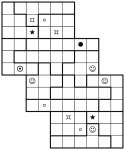
3-grid Shape Jigsaw Sudoku Samurai Stack
I needed to create one of these for a project elsewhere, so I thought I would post a couple of them here too – since I’d gone to the effort to make one at all! It’s not a new Sudoku variation, but just a very simple replacement of the digits 1 to 6 with shapes. None the less, it does make the puzzle notably harder to solve (or maybe that’s just me!). Unless there’s demand I won’t post this variant again, but I thought it would make an interesting change just for once!
I’ve created two examples – one is a simple 6×6 jigsaw, and the other is a 3-grid 6×6 Samurai Stack. In each case place one of each symbol into each 6-square row and column of each underlying 6×6 grid, and also one of each symbol into all of the bold-lined jigsaw shaped pieces.
Good luck!
Something different: Word ladders
Apr 21st
I’ll return to Sudoku very shortly, but today I thought I’d try something completely different. I’ve been working on various word puzzles for a new book, and thought that I’d post some of them here from time to time.
The attached puzzles here are four regular word ladders, albeit written on their sides if you open and view the PDFs. They were popularised in the late 19th century by Lewis Carroll, author of Alice’s Adventures in Wonderland (so I’m not claiming they’re anything new! ![]() ).
).
The rules are simple – by changing just one letter at each stage, can you move from the first word to the last word whilst using only standard English words in-between? I have a solution for each of these, and I’ve avoided any obscure words in order to keep it nice and fair.
For a simple example, you could change THE to SEA in three steps like this: THE -> SHE ->SEE -> SEE.
(By the way, using an unusual plural you can do the TRICKY CLONES one in one less step than the puzzle shows. ![]() )
)
Incidentally, I’m considering trying diagonal consecutive Sudoku for my next Sudoku puzzle – I just need to decide how to display this on the printed grid! Hollow slashes between two cells are a bit confusing because they seem to point at two different adjacent cells when they indicate consecutive-ness between diagonal cells (and look odd when they overlap), so I might have to experiment a bit to get it to work nicely. Perhaps two slashes, one in the corner of each diagonally-consecutive cell, would be best.
5-grid Samurai Skyscraper
Apr 20th
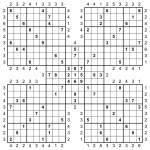
Samurai 5-grid Skyscraper puzzle
I thought I’d try one more Skyscraper Samurai Sudoku puzzle – this time a 5-grid variety, or what I think of as the ‘traditional’ Samurai Sudoku format (some people also call this Gattai-5, but I’ve not seen that in print anywhere).
The aim is to place 1 to 9 into each row, column and 3×3 bold-lined box of each of the 5 9×9 Sudoku grids, whilst also obeying the Skyscraper constraints. These tell you the number of digits that can be ’seen’ from the edge of the grid looking in along the adjacent row/column, where higher numbers obscure lower ones. Take a look at a couple of last week’s puzzles if you need more detailed instructions for this constraint.
As has been pointed out in the comments elsewhere, it doesn’t matter whether you consider that the Skyscraper clues apply to the nearest 9×9 grid or to the entire width/height of the row/column they attach to – once the first ‘9′ is reached then there are no higher numbers, and that’s guaranteed to happen within the first 9 squares.
I think this is probably about as large as you want to go with a relatively complex constraint such as Skyscraper, which is why I’ve included quite a few given numbers too – including some which clearly aren’t needed to give the puzzle a unique solution. (But please tell me if I’m wrong about this being big enough – I could always make a much larger one still just to prove that it’s possible!)
This week I plan to try out some other types of consecutive Sudoku variant – there are a couple of moderately-well-known types where you specify certain relationships between adjacent squares, such as ‘x2′ (where one number is twice the adjacent one – a bit like a slightly less-constrained version of consecutive sudoku!). If you have any ideas for other variants, feel free to let me know – I might try them out!
Good luck!
Consecutive Samurai Star
Apr 17th
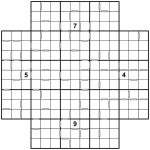
Samurai Star Consecutive puzzle
If the smaller consecutive puzzles weren’t enough of a challenge then this one should be! There are five overlaid 9×9 grids (including a ‘hidden’ one in the middle) which each need to have 1 to 9 placed into every row, column and bold-lined 3×3 box. On top of this you must obey the consecutive constraints – numbers with a white bar between are consecutive (12, 23, 34, 45, 56, 67, 78 or 89) and those without a bar between are not consecutive.
As you can see, the combination of tightly-overlaid grids and the consecutive marks means that very few givens are needed! Remember that none of these puzzles need ‘complex’ solving logic (you don’t need hidden or naked sets, X-wings or any other even more exotic strategy).
Good luck!
PS If there are any particular Sudoku or Samurai variants you’d like to see, please let me know and I’ll see what I can do!
Skyscraper Jigsaw Samurai Sudoku
Apr 16th
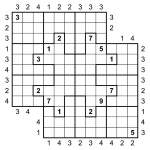
Skyscraper Jigsaw Samurai Sudoku puzzle
I’m pretty confident that you won’t have come across one of these puzzles before – I certainly haven’t! It’s a Samurai Skyscraper Sudoku puzzle with Jigsaw regions instead of regular 3×3 boxes.
The aim is to place 1 to 9 into each row and column of each of the two overlapping 9×9 grids, and also place 1 to 9 into each of the bold-lined jigsaw pieces. On top of that, you must also obey the Skyscraper constraints, which are the numbers outside the main puzzle grid. They specify the number of digits you can ’see’ from each point, where higher digits obscure lower digits (so a 7 obscures 1 to 6, and a 9 obscures all other digits, for example) – see yesterday’s post for a slightly longer explanation of how these constraints work.
Good luck!
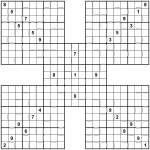
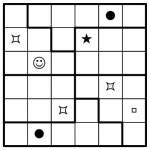





Recent Comments